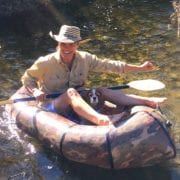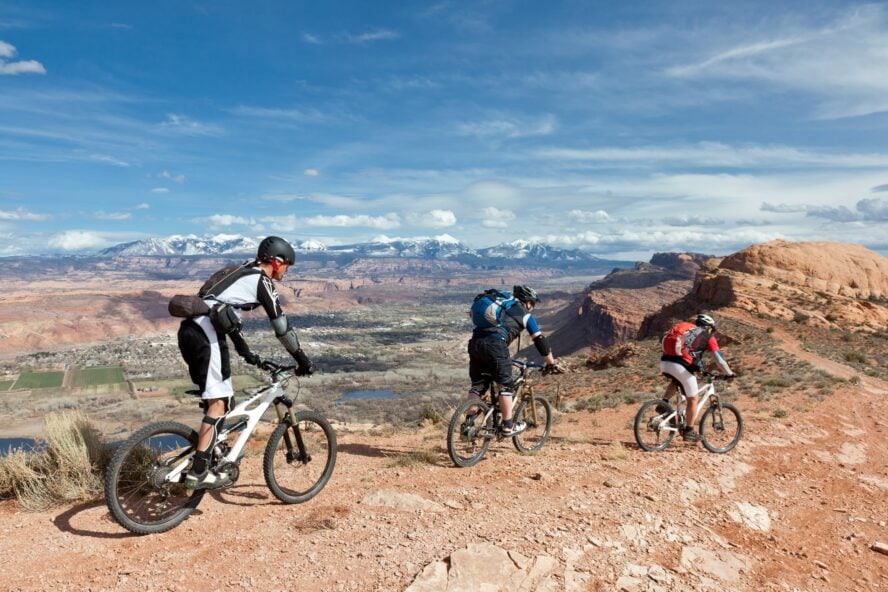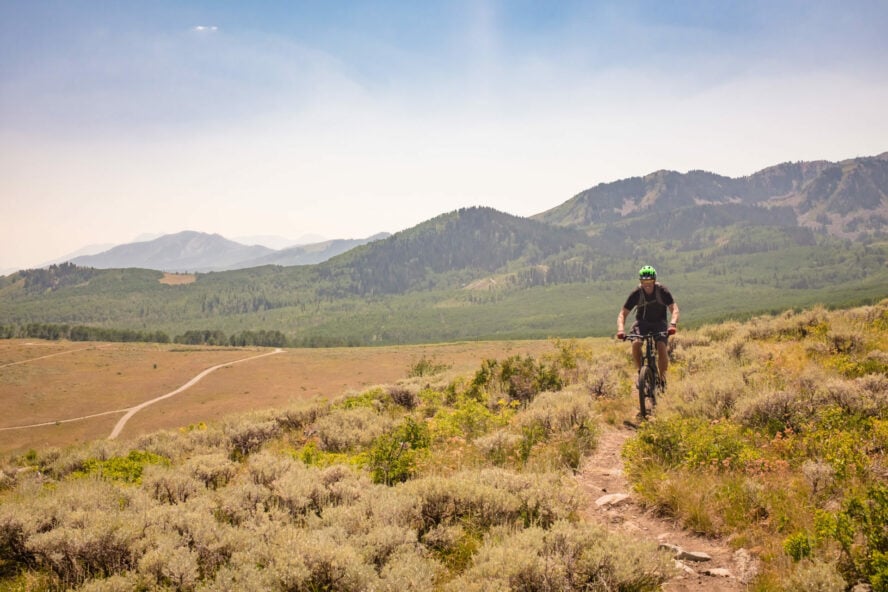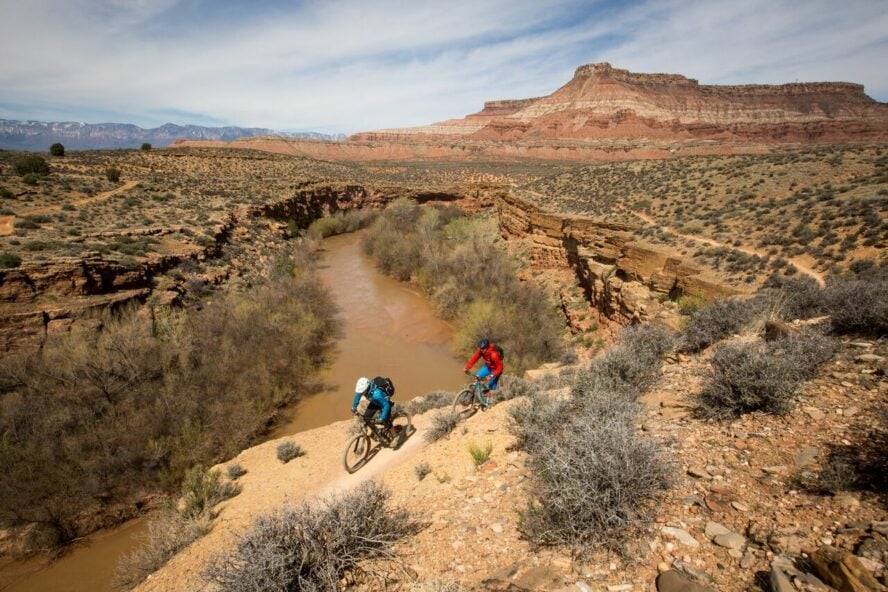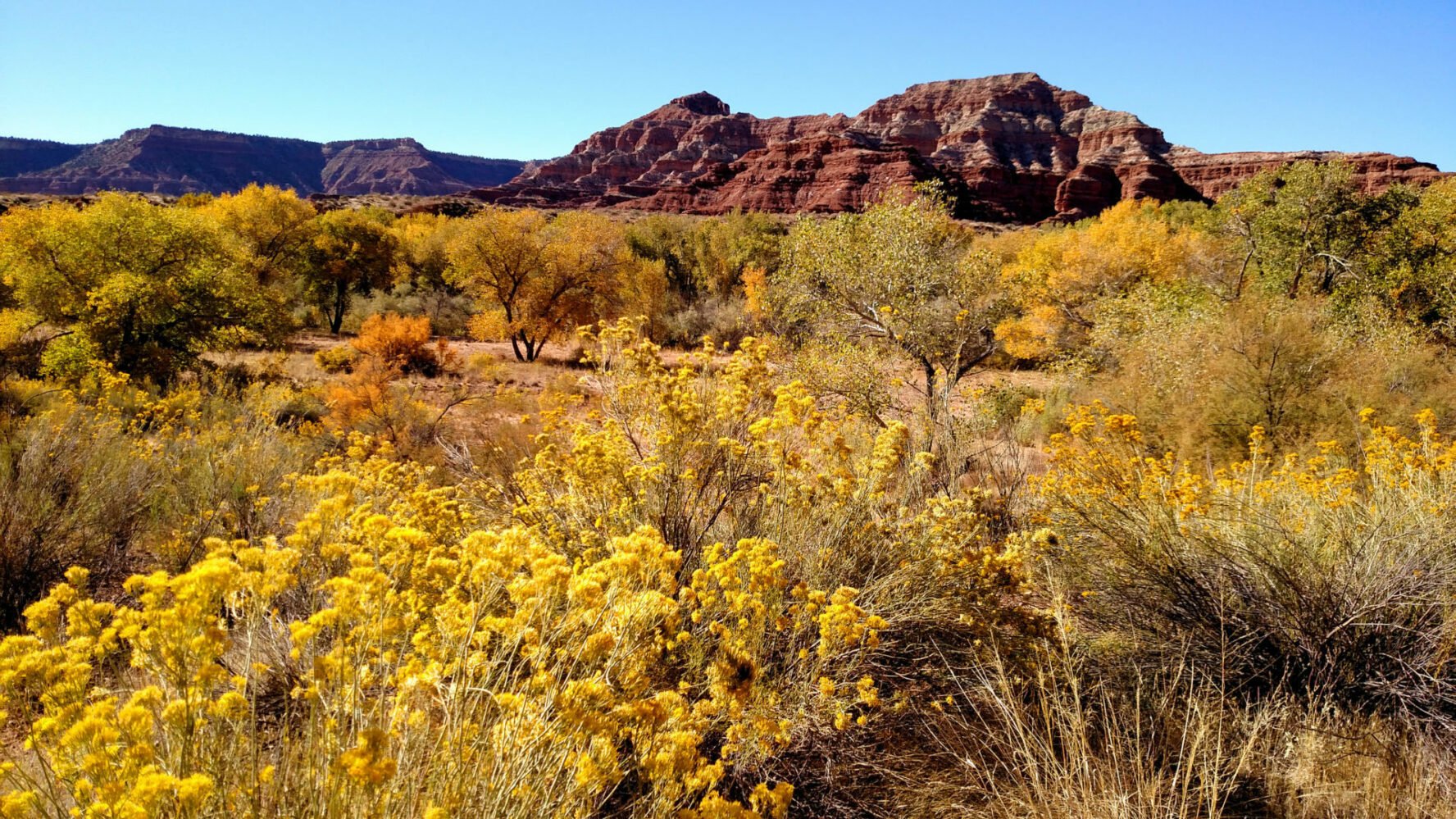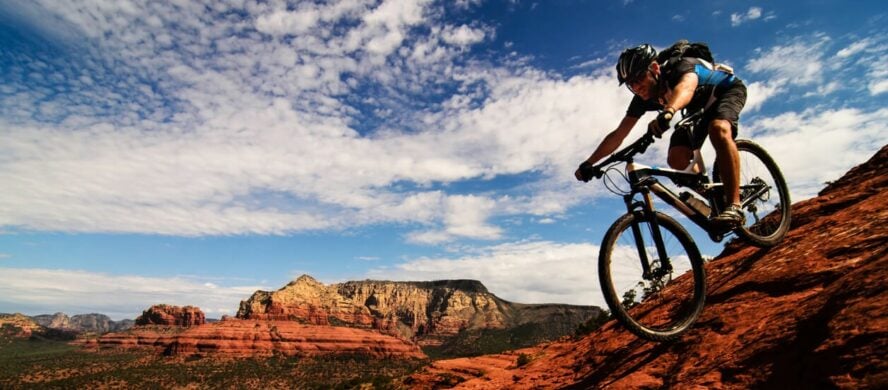Adventure seekers are drawn to the state of Utah’s “Mighty Five” national parks, 45 state parks, and over 1,203 mountain biking trails spanning 3,788 miles – and still growing. Moab needs no introduction — it’s world renowned. Traveling into the Salt Lake City and Park City areas, you get the best of both worlds. In southwestern Utah, St. George and Hurricane are also putting themselves on the map. Oh, and a good portion of trails in the southern part of the state are rideable year-round. There’s truly something for everyone in Utah, the state seemingly designed specifically for mountain biking.
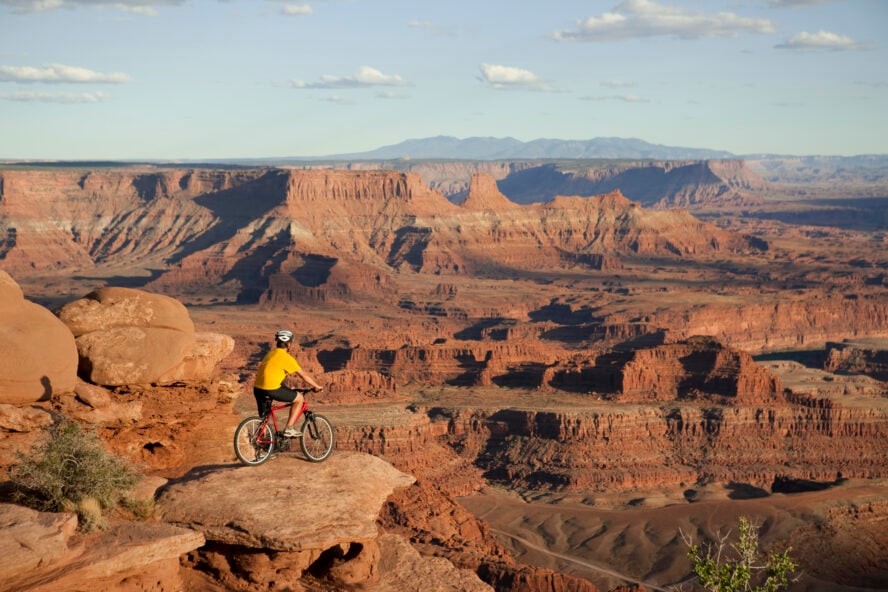
Where can you mountain bike in Utah?
You can mountain bike across Utah, with trails concentrated in pockets all over the state. The up-and-coming Salt Lake provides plenty of restaurants, breweries, and art destinations, all with quick access to the mountains and to attractions in Park City. Did you know Park City is also the world’s first International Mountain Bicycling Association (IMBA) Gold Level cycling destination? Heading toward the Colorado border, you can be in Moab in just under a four-hour drive from Salt Lake City. Moab offers plenty of technical routes for the more experienced rider and its copious red rock and sandstone makes it feel like you’re riding the mountain bike trails in Sedona. Or on another planet.
Traveling Bryce Canyon, St. George and Hurricane for Utah’s mountain biking trails, each area has equally enticing and compelling reasons to visit and ride. The nearby Gooseberry Mesa trail network is a major draw because of its temperate weather in colder months. It’s the perfect location to enjoy some late fall and winter mountain biking. Southern Utah also has so much to offer on and off the trail.
When is the best time to go mountain biking in Utah?
The mountain biking season in Utah is long, depending on your tolerance to varying temperatures. Many of the hot spots in southern Utah are situated at a high elevation, so don’t let its location fool you. I’ve definitely woken up near Bryce Canyon with frost on the tent in September. Zion is another high-altitude area that can surprise you with its falling temperatures. Spring and Fall are ideal for visiting due to moderate temps. In the summer, high-altitude areas such as Park City can be a bit of a reprieve from the desert heat. Depending on the trail, you can find sun and shade into the late parts of spring to early summer and late summer to fall.
Tips to find camping in Utah
The Bureau of Land Management camping sites, better known as BLM land, is all over the West. Utah is ripe with free camping spots across the state. Many are undesignated, meaning you get to make your own homestead, and all are first come, first served. It can still be tricky to nail down a spot in areas such as Moab or close to the park, so arrive early and plan ahead. BLM land can be found on apps such as iOverlander.
Utah is an outdoor adventure playground worth the travel
Utah is a major player in the local and international mountain biking community and the perfect MTB destination, but the adventure doesn’t stop there. You won’t want to limit yourself to one section of the state. Whether you are near Salt Lake City, in the mountains or near the famous Zion National Park, you can find some of the best hiking trails in the U.S. and incredible climbing in Utah. Discover arches, hoodoos, mesas and slot canyons while riding some of the best track this country has to offer.
Without further ado, here the best trails for mountain biking in five of Utah’s top MTB destinations:
1. Moab
Moab’s mountain biking terrain, abundance of tracks, climate and adventure community are only four of the numerous reasons mountain bikers put this desert destination on their bucket list. You’ve heard about Utah’s featherlight snow, but Moab makes a strong case for the title of the greatest mountain biking around. You’ll find over 900 miles of Moab MTB trails. The majority of tracks are ideal for beginner and intermediate riders — all tucked into and around this quaint town that appeals to a range of tastes.

Moab stands out as a major player in the MTB community
The community here plays a strong role in Moab’s prominence on the circuit — it actively maintains and builds forgiving and not-so-forgiving routes. Moab, Arches National Park and La Sal Mountains are not only stunning, but also significant due to the rich Indigenous history of the area. Ancestral Puebloans inhabited the Moab area as early as 10,000 years ago, developing farming lands and sacred spaces in the mountains as the backdrop.
Moab mountain biking is the challenging ride you might just need
In the infancy of Moab mountain biking, Slickrock Trail was featured on the cover of the very first issue of Mountain Bike Action magazine and the town never looked back. Today, the outdoor destination attracts gearheads, glampers and spiritual vortex seekers alike. While all levels of riders can’t get enough out of Moab’s sandstone and the feeling like you’re riding on another planet, it’s the technical, difficult-rated tracks that make Moab stand out from other top-rated destinations in the country. Think of it this way: one mile of technical in the desert can feel like three miles elsewhere. So keep that in mind when you’re riding a “short” ten-mile track.
New riders don’t have to be left out. You can find plenty of options in Moab for mountain biking to become a better rider. Keep in mind: the desert climate mustn’t be underestimated. Always bring more water than you need, extra tubes, tools and a map. Make sure your bike is tuned. You don’t want to be that person in your group who goes home early due to the fact you thought you could wing it without a tuneup.
The Best Mountain Biking Trails in Moab
Moab is situated between Arches National Park to the north and Canyonlands National Park to the southwest, so there’s plenty to explore when your body needs a break. If you’re not into hiking, there’s rock climbing, skydiving, motorsports, and backcountry skiing. Yes, you can find skiing in the La Sal mountains if you want to combine your seasons. Moab itself has decent food, breweries, boutiques and shops to take care of rental and repair needs. Some of the shops even have a shower if you’re going to be camping.
Moab isn’t always the easiest last-minute outing. You’re really going to want to get your bike tuned up, pack in some extra water, and plan ahead to find camping or lodging. With over 200 trails to choose from, and maybe only 57 hours worth of time to ride, you can always go on a guided MTB tour to get a jump on what and where you’d like to ride. I’ve included some of my favorites.
The Whole Enchilada — a Moab classic
Spanning over 34 miles and almost 8,000 feet of descent makes the Whole Enchilada a bucket-list ride drawing people from all over the world. Time of year permitting, the route starts from Geyser Pass in the La Sal mountains and makes its way to the Colorado River. Another standard start is Miners Basin to avoid snow and wet trails in early and late season. You’ll want to set up a shuttle with friends, or save yourself some time and hire a shuttle. Some will tell you the Whole Enchilada has supplanted the classic Slickrock Trail as Moab’s signature ride. That’s for you to decide.
Captain Ahab for technical, difficult riding
Captain Ahab is located in the Amassa Back Area via Hymasa trail. Intermediate riders should expect to walk in certain sections but worth the challenge. The trail is said to be thought up by a mechanic at Poison Spider Bicycles in Moab, which continues to donate to local land agencies to maintain and develop the track. Captain Ahab is technical and demanding with just enough downhill at the end to forget all the rocky and rugged ups and downs. The lower sections can easily be turned into laps, if you’re up for it.
To reach Upper and Lower Ahab, you’ll need to take the Hymasa trail. Thankfully, it’s a quick climb and winding track over slick rock that will only get your heart rate up. Overall, get ready for a really doable ascent. Plus, the views over Jackson Hole make you forget about the grind for a moment.
Slickrock is one of the best destinations for a desert riding
Slickrock is the trail that launched a thousand tracks — and arguably the best mountain biking in Utah. It’s also 10.5 miles of physically and technically difficult terrain. The trail really is that good thanks to tacky, weathered-smooth slick rock and stunning scenery. The trail is mostly rock instead of traditional single-track. Riders follow white dashes on the slick rock to help you navigate the trail. It’s shocking at first that your tires will hold. A perennial favorite, Slickrock is what put Moab on the mountain biking map.
Plus, red sandstone gets along really, really well with mountain bike tires, which may or may not inspire you to try riding vertically up a wall. You’ll want to try. Also, bring water. Lots and lots of water. And please leave your dog at home.
The Amasa Back area has some of Moab’s best enduro-style riding with fast descents over steep rolls, drops, and ledgy features.
By Lily Krass – Backcountry skier, mountain biker, hiker, and Jackson Hole local
Moab - Good to Know
Intermediate to advanced
Slickrock, ledges, dirt and the odd exposed ridge
Hymasa as an out-and-back ride
Moab is one of the best rock climbing destinations in the USA, so if you have the time, get out on the rocks. Moab is also known for its sky diving with full panoramas of the desert!
4,689’
Moab camping can be its own competitive sport. Plan ahead and arrive on Thursday morning if spots are first come first served.
2. Park City
“What goes up, must come down” is the best description of Park City mountain biking. You might not know it’s the largest mountain resort in the U.S. with 348 trails and 41 lifts over eleven-square-miles. With uphill-only and downhill-only tracks, cross-country, enduro, freeride, downhill, lift-served and fat bike trails, you’ll be able to put your skills and courage to the test. The fun part is that you choose one trail or connect with others for a whole day of loop riding in Park City’s beautiful wilderness.
Park City also offers a rather charming downtown scene with plenty of Western flavor. The town was founded in 1884 after the silver boom, so its mining heritage is still at the core despite catering to a jetsetting crowd.
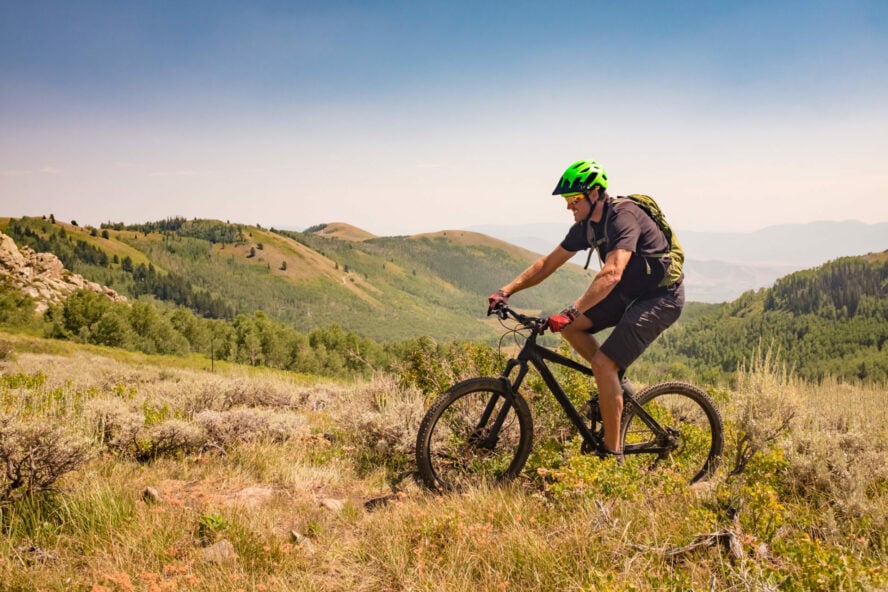
Park City pairs expansive beauty with gold-level mountain biking
Park City was the first mountain biking destination to receive the Gold-Level IMBA Ride Center. The mountain destination is also one of only seven in the entire world that get to claim that title. Park City’s mountains offer more than 450 miles — and counting — of public trails (over 300 miles of singletrack!) Once you realize how many trail options there are for all skill levels, you’ll understand why MTB in Park City is on so many mountain bikers’ bucket lists.
When is the mountain biking season in park city?
The regular mountain biking season in Park City starts in late May. If you’re looking for lift-serviced bike parks like you’d get mountain biking in Colorado, Park City has plenty to offer starting operating in June. On the other hand, if you’re looking to do Wasatch Crest or other high-altitude trails, I suggest you don’t go before mid-July, as there’s still a risk you’ll encounter some snow before the real summer starts. Let’s not forget that Utah is the state “with the greatest snow on Earth” and there’s always plenty to go around.
Park City delivers plenty of off-trail entertainment
After a day spent on the trails, there’s more than 100 bars and restaurants, excellent accommodation options, art galleries, and mini-amusement parks, making Park City an ideal place for a whole family mountain biking vacation. You can rest your legs while doing some fly-fishing, go for a swim, rent a boat, jet ski, or paddleboard at the nearby Jordanelle Reservoir.
Finding accommodations in Park City won’t be a problem. From luxury hotels, to budget-friendly condos, huts and townhouses, Park City gives a range of styles. If you don’t want to stay at the resort, you can choose Salt Lake City instead, as there are plenty of lodging options there as well. Getting to Park City won’t be a problem either, as it is located a short 45-minute drive from Salt Lake International Airport.
The Best Park City Mountain Biking Trails
Climb up the uphill-only Armstrong, make your descent at the Mid Mountain Trail for the 30 miles of pure fun, or try the challenging Wasatch Crest enduro trail. Park City really has something for all skill levels.
Wasatch Crest Trail is Park City riding at its best
If there is one Park City mountain biking must-ride, it’s the Wasatch Crest trail starting at 9,800 feet elevation. The trail sits atop the Park City ridgeline giving you a 360-degree view of the Wasatch Mountain range It is not for the faint of heart, as it’s 12.5 miles long trail with an uphill section of 4,000 or 1,600 feet vertical climb, depending on if you want to take the Crescent Lift or the heel-toe express. You can also shelf-shuttle or hitch a ride with a service for Wasatch Crest. Keep in mind, this trail requires moderate to advanced technical ability in certain areas.
Amstrong is an uphill to get your heart racing
Armstrong Trail is a recent addition to the Park City trail network and mainly acts as a connector. Armstrong is an uphill only trail, coming in at 4 miles long, making it a great option for accessing Mid-Mountain and Spiro. The trail features a gentle grade to the top, and although it’s not technical, the ride still requires a fair amount of physical fitness.
Classic cross-country trail: Mid Mountain
The Mid Mountain Trail is an IMBA Epic trail featuring 21.9 miles of singletrack. Starting at either Park City or neighboring Deer Valley Resort, you’ll find lots of climbing, descending and riding through forests. Standing at 8,000 feet for the full duration makes this a super fun intermediate trail. You might want to tackle this one on day two or three of your trip to give yourself some time to acclimate before the high-altitude ride. The scenery here is truly stunning, especially in fall with the leaves changing. A few rocky sections and plenty of climbs to keep this ride entertaining. Take my word for it, or better yet, find out for yourself.
Beginner-friendly Lost Prospector is classic singletrack with views of Park City
Looking for something to ease into your Park City MTB trip? Beginners and young members of the group will appreciate Lost Prospector for its lack of technical terrain through groves of quaking Aspen trees. Riders can also access the trail from different points in Park City to soak in fantastic views of the town and the resorts. You can ride this as an out-and-back or a loop if you want an easy cruise along the Historic Union Pacific Rail Trail.
It’s a great introduction to single-track mountain biking with only 600 vertical feet of climb. To make the ride a 7.8-mile loop, park at White Pine Touring. You’ll hop on the Rail Trail to connect to Skid Row for some switchbacks before meeting Lost Prospector as it runs along the hillside opening to views of quaint Park City below.
Park City was the first mountain biking destination to receive the gold-level IMBA Ride Center and is currently one of only six in the entire world that can brag about this level of recognition.
Park City - Good to Know
Beginner to advanced
Singletrack, downhill, uphill, cross country
Lift service starts in June but wait until snow melts in mid-July for high-altitude trails
Head to town to walk the strip. Be sure to come back in the winter for some of the best backcountry skiing in Utah.
Lost Prospector is perfect for getting acclimated and familiar with a rental
Stay at an Airbnb or in Salt Lake City if you’re looking to save on lodging
3. Hurricane and St. George
Located in the southwestern corner of Utah, far removed from bigger draws like Moab and SLC, are a cluster of towns that have some beautiful trails near the world-renowned Zion National Park. If you’re on your way to Zion or Las Vegas, you could easily miss the area, but it’s worth a stop for remote mountain biking tours in Hurricane. Over the past several years, Hurricane and its neighbor, St. George – they’re only 18 miles apart – have firmly established themselves as destinations for Utah mountain biking in their own right. The Hurricane Rim Loop, near Hurricane not so coincidentally, is an IMBA Epic ride. It’s a perfect compliment to a trip to Zion, or alone, thanks to their gorgeous, trail-linked systems.
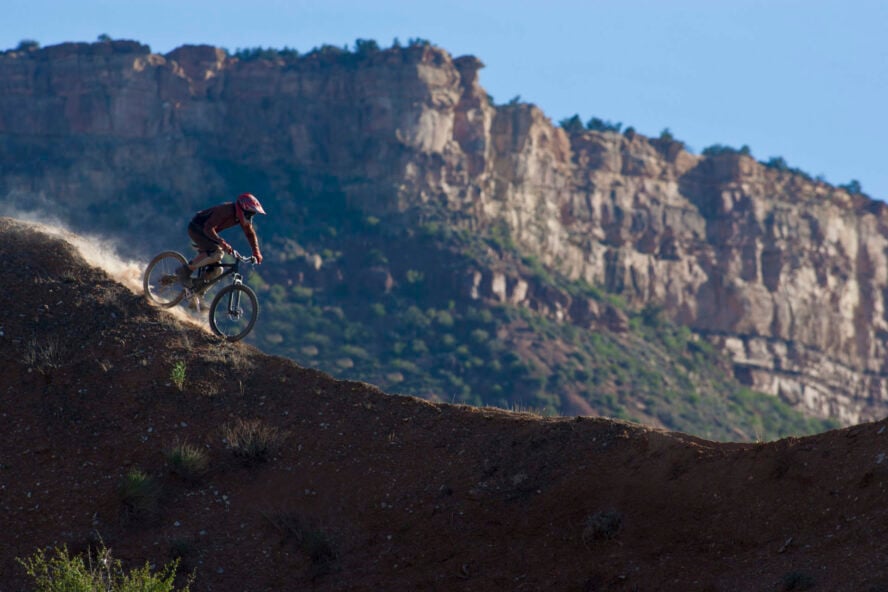
Hurricane offers some of the best hidden mountain biking in Utah
Hurricane’s approached its trails with intention versus some other MTB destinations that developed over time in Utah. Most of the trails are all purpose-built with tons of connections to ensure a full day of riding, rather than driving from trail to trail. In contrast, a lot of trails in the Moab area are former roads and had their trails adapted along the way. In addition, the views of Zion and the Kolob and Canaan Mountains from Gooseberry Mesa are astounding. Good news, there’s plenty of slickrock to be ridden here as well.
Gooseberry Mesa: a big loop with wide-open views
Want to see Zion National Park except without the crowds? Gooseberry Mesa is a 13-mile classic. Built over 20 years ago, its creators and the mountain biking community work hard to maintain it. Respect. The trail has plenty of slickrock, tight singletrack and views for days. Plan on at least four hours. Don’t forget to bring plenty of water, as there’s none to be found on the mesa.
Little Creek Mesa: West Loop is ideal for technical pursuits
Finding the trailhead for this gem is almost as challenging as some of its terrain. Keep an eye out for large cairns past a pond to take a right onto the West Loop trail. It’s definitely worth a little sleuthing for the payoff. The open slickrock and singletrack rewards all takers with stunning views of the Pine Valley Mountains and Gooseberry Mesa from the rim. You’ll also encounter some technical moves, meadows and challenging features. This one is best left for experienced riders due to its terrain. Riders looking for flowy singletrack won’t be disappointed after riding all nine of its awesome slickrock miles.
Hurricane Rim Loop combines three trails in Southern Utah
Hurricane Rim Loop is another big trail that defines St. George mountain biking. It’s just over 24 miles, and it’s a gem. This ride combines three different trail systems – the Hurricane Rim Trail, Goulds Rim and JEM Trail – and was lately featured as an IMBA Epic ride. Expect more incredible vistas, easy climbs and flowing descents in this link-up system. Advanced riders will appreciate the technical aspects and fast drops to keep things interesting.
I love the St. George and Hurricane areas because when everything else in the country is cold, and even other parts of Utah, these areas are usually sunny and warm.
By Cody Bradford — IN MEMORY: AMGA CERTIFIED ROCK GUIDE AND 57HOURS AMBASSADOR
Hurricane and St. George - Good to Know
Intermediate to advanced
Slick rock, singletrack
Year-round
Head to Zion National Park
Snow Canyon State Park Campground, Sand Hollow State Park
4. Salt Lake City
Salt Lake City is enjoying a moment as people are flocking to the affordable city for its outdoor elements, as well as its dining, street art, live music, and even breweries. Yes, you can get a decent drink here. If you’re not accustomed to the elevation, Salt Lake provides plenty of activities for a day or two of acclamation.
I love the airport for its simplicity, amenities, and ease from which you can get from the terminal to all over the city. Plus, the proximity to Park City can be a bit staggering. When I first visited SLC, we drove up 190 to Park City to take in the sights and partake in incredible sushi at the resort area before easily heading back to our hotel for the night. Let’s just say I was hooked. Salt Lake is the best of both worlds if you want access to the outdoors and a range of comforts.

Get your grounding at Quarry Trail in Little Cottonwood Canyon
Salt Lake City is famous for its Mormon population and temples. Quarry Trail is a treat to see where the massive granite blocks were harvested for the city’s iconic Salt Lake Temple and chiseled from the rocks. Begin near the base of Little Cottonwood Canyon for steady but doable climbing. Speaking of climbing, Little and Big Cottonwood feature some worthwhile climbing in Salt Lake City. The Quarry Trail is a reprieve from hot desert sun thanks to its shaded sections and cool air while winding along a riverbed. Beginners will love this trail because it’s an approachable training ground for fitness and technical skills. I enjoyed the simple rock gardens and stunning colors of the leaves in Little Cottonwood during a fall visit. I hear you can sight the occasional mountain goat on the faces of the canyon if you can take your eyes off the trail.
Due to its easy access and views, Quarry Trail draws crowds on weekends and as part of the afterwork set. Aim for midweek if you want more space for yourself. Also, because Little Cottonwood is a protected watershed, dogs can’t join on this ride.
Access Bobsled via Bonneville Shoreline Trail for an adrenaline rush
You’re going to love the technical elements and gravity defying berms at Bobsled Trail, just north of Salt Lake City. Littered with loose rock on the descent, you’ll get a payoff from the quick banked turns that follow through the trees. For that reason, Bobsled is perfect for downhill enthusiasts and freeriders looking for a challenge. Access the track from the Bonneville Shoreline Trail. Expect to climb up a steady ascent from the access point at Popperton Park, with a few technical elements to keep you alert.
Fun fact: the name will make sense after a few of the impressive banked berms seeing Salt Lake once hosted the Winter Olympics. If you’re not feeling the need for the speed — or taking some air — you can always navigate around the junked cars acting as launching pads for riders.
Mueller Park for technical singletrack winding to exhilarating downhill
Head to Bountiful, just north of Salt Lake, to find Mueller Park’s 13-mile sculpted singletrack winding through pines. This out-and-back trail is a sweet spot for intermediate riders thanks to 1,900 feet of climb, speedy downhill with plenty of flow, and moderate technical elements. Once you hit Elephant Rock around mile seven, you’ll get into the more of a challenge. It won’t knock you out though. Even though you’re close to the city, it feels more remote riding through conifers and gamble oaks, not to mention climbing drainages and small canyons until you reach Rudy’s Flat. This is also a nice flat spot with a viewpoint, perfect for a rest before heading back out.
Quarry Trail is a treat to see where the massive granite blocks were harvested for the city’s iconic Salt Lake Temple and chiseled from the rocks.
Salt Lake City - Good to Know
Beginner to advanced
Singletrack, downhill, classic
June through October is reliable
Head to Temple Square, climbing at Little Cottonwood or set out to find famous Spiral Jetty earthwork
Quarry Trail
You can only buy beer that caps at 5% alcohol content from anywhere other than a state-run liquor
5. Bryce Canyon National Park
Southern Utah is a world unto itself. Bryce Canyon National Park is truly stunning and stands out among some of the most impressive landscapes in the state — some might say the world. Bryce is also the smaller cousin of Zion, which means slightly less crowds and all-around mania. It feels like the middle of nowhere, which it technically is, but the mountain biking trails are well worth the detour if you’re in the area.
Base your mountain biking trip out of Panguitch
Panguitch is a small town just 25 miles from Bryce with a neighboring lake bearing the same name. Late May to September you can camp around the lake, setting you up for fishing for rainbow trout and access to the nearby track.
I really can’t say enough good things about taking Scenic Byway 143 to this section of Southern Utah. You can make stops along the way at Escalante, known for its slot canyons, rafting and waterfall that flows year round at Lower Calf Creek Falls. If you’re coming to this part of the state, I highly recommend putting your bikes on a rack and making the quintessential American road trip to Panquitch.
Thunder Mountain Loop
Just under 16 miles, Thunder Mountain Trail features plenty of climbing and iconic desert formations outside Bryce Canyon National Park. The descent among the Red Canyon’s hoodoos, towering rock formations, are a trip. We also rode along knife ridges and switchbacks on mostly smooth hardpack. That’s not to say there aren’t some sketchy sections of loose and steep. Thunder Mountain is rated advanced black after all, but most of the trail will present solid blues for moderate riders looking for a worthwhile challenge. As a bonus, the last mile or so is flowy downhill perfect for gliding down. You won’t encounter many steps or drops. Any technical sections are quick and easy to walk if preferred. What makes it harder is that you are riding at over 8,000 feet elevation, but hardly the highest tracks in the area. Climbing is typically moderate and views certainly help as a payoff.
I recommend riding the full loop to get the scenery and views, if you’re up for it. You can also ride from the upper trailhead to the lower trailhead, with a car shuttle back to avoid several uphill sections that are a pain.
Bunker Creek Trail
Welcome to some serious downhill through gobstopping history. Brian Head Peak is formed of a pale, soft, volcanic rock, deposited during the last 20 million years in an area that is believed to be the bottom of a lake at one point. Pretty wild to think of the desert as a dried-up body of water. The bright pink cliffs of Cedar Breaks are formed of limestone from about 40 million years ago. For the scenery alone, the Bunker Creek Trail is worth a trip. It’s an epic downhill at Brian Head Peak, starting at a mere 11,300 feet. I recommend you bring some layers for this altitude, regardless of the time of year.
You’ll head east to Panguitch Lake on a thrilling 3,000 feet descent. It might sound intimidating, but the trail is doable for intermediate riders especially thanks to shuttle service for the return trip. The singletrack trail is 11.6 miles long and is worth paying for a shuttle to get there and back. The bike shops in Brian Head provide shuttle service for around $25 per rider. You’ll get a ride up to the trailhead on Brian Head Peak, then scooped up at Panguitch Lake once you’ve unclenched your hands from the bike.
The landscape has an almost alien appearance, with red rock spires erupting from the desert floor, eroded sandstone arches, and dramatic rock formations around every turn.
By Maggie Slepian – Backpacker, trail runner, climber, and mountain biker
Bryce Canyon National Park - Good to Know
Intermediate to advanced
Singletrack, crosscountry
Spring and fall are best
Head to Bryce Canyon National Park
Bunker Creek Trail

